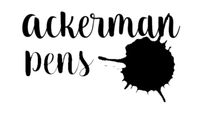About Ink Feeds
The ink feed is the second most important part in a fountain pen. The nib is the most important - the business end of the pen that lays down your drawn line, but if the feed doesn't feed ink to the nib correctly, it doesn't matter what nib you're using.
We produce all our feeds for our pens. We've produced a variety of feed designs over the years searching for what works best with popular nibs. We have worked with ebonite, which has a good reputation for feed material, but we found a modern plastic that provides 95% what ebonite provides, and it's easier to work with.
We provide three categories of feeds:
- Large nib feeds that fit most large flexible nibs, such as Manga G, Brause Rose, Hunt drawing nibs, our Sketch and Music nibs, and Principal nibs.
- Small nib feeds designed for specific small nibs, such as crow quills, Hawk quills, and Gillott nibs.
- Specialty nib feeds designed for popular drawing nibs with a unique shape, such as Speedball Broad Edge Nibs and Brause Blue Pumpkin nibs
Large Nib Feeds
We provide three large nib feeds:
- Thin flow feeds are designed for with thin inks, mostly fountain pen inks that some people prefer
- Standard flow feeds are designed for medium thick inks, such as thin India inks and Golden Hi=Flow acrylic
- Rich flow feeds are designed for thicker India inks, such as Speedball, Bombay, and Platinum Carbon ink.
By default we ship the standard feed with every Classic Fountain Pen and Pump Pen because that size feed works best in most situations. You can order Thin flow and Thick flow feeds separately or in a set. We can't predict which feed will work best for you because many variables control the flow of ink through a pen. The most important variable is the viscosity of the ink, but surface tension and temperature are also important. All three physical forces can vary over time and independently of each other. If you grip a fountain pen by wrapping your fingers around the barrel and hold the pen parallel to the ground, then lift the tip ten degrees, you will eventually see ink drip from the tip because the heat of your hand warmed the ink and expanded the interior contents of the reservoir.
You can insert and remove Large Nib Feeds by hand. If the nib or feed gets stuck in the pen, you can force them out using a firm thin rod, like a chopstick.
Small Nib Feeds
We provide three small nib feeds:
- Crowquill feeds fits most crowquills currently in production
- Hawk quill feeds are slightly larger than crowquills and not as popular
- Gillott feeds fit the Gillott 303, 404 and 170 nibs. The 170 nibs is much smaller, but very precise. The 303 and 404 are identical in size and shape, but the 303 is more flexible. The 303 is used for drawing while the 404 was used for writing, although some artists like its stiffness. It has been reported that Lincoln wrote the Gettysburg Address using a fountain pen with the Gillott 404 nib. Gillott nibs could well be the oldest nibs in continuous use, and have long been preferred by artists for their amazing flexibility.
Most of these nibs never had a feed. These feeds have a simple surface geometry due to their small size. There are several problems fitting feeds to these smaller nibs.
- Getting a good fit is difficult because small nibs cheap so they are made from inexpensive material that varies in quality over time. Sometimes the steel is good, and sometimes it isn't.
- Ink is a corrosive liquid, and degrades small metal objects made from inferior material. Dip nibs rust quickly. They can also snap easily if you press too hard.
- The nibs are produced in large quantities, so the quality suffers. A professional illustrator working full time could go through three or four crowquills in a single day. A professional illustrator will also inspect each nib they buy looking to avoid nibs with rough edges and poor production quality.
- Small nibs are very flexible and don't always keep their shape.
- You have to jiggle small nibs to feed the "sweet spot" that provides the best feeding.
We continue to improve our feed designs and explore other methods to feed ink to nibs.
